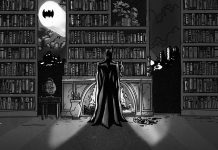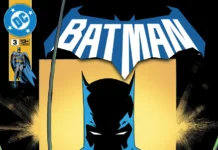 Another DC BLACK LABEL book is shaping up to be a great story.
Another DC BLACK LABEL book is shaping up to be a great story.
This shouldn’t surprise anyone. I hoped this would be the case when I reviewed the first issue, and we’re headed in that direction. We’ve got Batman on his own, fighting the mob, trying to solve a very strange series of mysterious crimes, and making some allies along the way. All in a 1939 setting that makes for a compelling historical backdrop. The art is still the highlight, and though we don’t solve the central mystery, we learn enough to stay engaged. Two issues into a three-part series, we won’t get too many familiar allies, but we learn more about the ones featured here. This is a good reminder that Alfred and Robin weren’t around from the beginning, and their absence is part of the homage, but also underscores how important they are to Batman’s history.
When we left Batman, he had uncovered a connection between the string of murders and recently executed criminals. Spoiler alert for issue one (which you probably read, but if not, you should), he went to Blackgate to stop another execution and find out what’s going on. Just as he intervenes, he’s shoved into the electric chair himself. The issue ends with him being electrocuted in the chair, which is a pretty shocking image (sorry for the pun).
I don’t want to give away anything about how he gets out or how he survives, but he does survive. It wouldn’t be much of a Batman story if he didn’t. The details reminded me of a two-part cliffhanger episode of the 60s series, complete with the crucial detail that explains the impossible thing we just saw. It’s not an exploding bat-radio, but it’s not that far off. That’s not a bad thing though! I read it as another homage to an important part of his history.
So, with that resolved, and after a bit of recovery, Batman keeps digging. And what do we learn? Mayor Vincent is still being targeted for murder. Julie Madison is a trustworthy ally keeping a few secrets herself. And, we learn that the mysterious “Voice” is one of the most powerful figures in Gotham who doesn’t mind extreme measures to get his way, one of which gives us a big action scene in the middle of this issue. We meet a new character mentioned in the last issue, Johnny the Whip. After some violent shootouts and another narrow escape, Batman visits Maxie’s brothel again (no, not like that) and finds out more about the Voice. Batman, with the help of Tillie, starts to see the connections between the murders and deduces there are other targets on his list besides the mayor, including some close friends.
As far as character development, we get an extended scene between Bruce and Julie Madison where Bruce is forced to be a lot more vulnerable than he’d prefer. We also get another scene between Batman and Rabbi Cohen, with some additional commentary on the role of religion in this historical setting. Batman takes some big steps towards openness here, to the point where it seems the rabbi might approximate the role of Alfred in this Batman’s life. But most interestingly, both Rabbi Cohen and Jim Gordon at different times encourage Batman to carry a gun for his own safety’s sake. And this is where we get Batman talking a little more about why he’s doing what he’s doing. He mentioned having seen the worst of humanity as a child in the last issue. Here he says that using a gun would betray something important to him. Does he pick up a gun? You’ll have to read to find out. But it matters to him to have friends so concerned for his well-being.
There are a lot of fun callbacks in this issue. Read the newspapers on the first page and look at the names. If you know the stories from DETECTIVE COMICS #27 and those immediately following, the names and stories will look very familiar. It’s pretty fitting to read this for his 85th anniversary! In the last issue, we saw Bruce Wayne tag along with Gordon to a crime scene, another callback to DC #27. We saw Batman driving around in his early days red Roadster in issue one. I’ll confess he seems to have lost it, though I’m not sure how, he just doesn’t seem to have it at a key part of the story. Readers feel free to let me know what I’m missing.
The art once again does a great job showing how Batman might have looked in a realistic take on his early stories. I still don’t love the ear style, but the white eyes didn’t bother me as much, even in the quieter moments where you want to see his expressions. I don’t blame anyone for not loving the purple gloves though. It depends on how faithful you want the homage to be.
The violence doesn’t let up at all from the first issue and on some pages goes even further. When guys seem to come back from the dead, something extreme has to happen to get them out of the story for good. Some of them aren’t coming back because there isn’t enough of them left. A no-killing rule stands out in a world like this.
Overall, this is a solid entry. There are stretches where I felt like the violence and shootouts were a little drawn out when I wanted to know more about the main mystery. But I’ll admit that solving the mystery is always my favorite part of Batman stories. And I know the exclusion of Alfred, the Batcave, the Batmobile and the rest is an intentional choice, but I do miss them. I don’t want to count that against the book though, because we’re getting a good BLACK LABEL homage to a time in Batman’s history when those things didn’t exist. So appreciate it for what it is.












